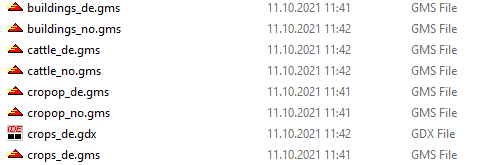Database
The database is located in the \dat folder and contains all the relevant information used in FarmDyn. It contains country or region specific agronomic, policy or emission data, which are denominated with the suffix of the corresponding country. In the example below, you can see files denominated with a suffix _de for Germany (Deutschland) and _no for Norway. Further, most data files are written in the .gms files, however, some of the data is coming from pre-processing steps and are given by .gdx files.
In addition to the data used in the agronomic, policy and emission domain of FarmDyn, the farm population can be generated in the file farmData_de.gms or any copy of it to generate a gdx file with the farm population.
 Figure 2: File structure with exemplary snippet
Source: Own illustration
Figure 2: File structure with exemplary snippet
Source: Own illustration
KTBL Database
The KTBL database reports detailed data for 145 crops, including for example main and catch crops under conventional and organic production and different tillage systems (till,mintill,notill). The data includes information on machine applications and related resource requirements, revenues and direct costs as well as agronomic information required in FarmDyn. A list of all crops and available combinations of crops, tillage and farming system (org,conv) are provided in the file c_s_t_i.gms. The KTBL database reports different implementations of a crop, which are associated with different machine requirements, revenues and costs (e.g. irrigated vs. non-irrigated cultivation, different processing and marketing options). In the file, a standard implementation is selected for each available combination of crop, tillage and farming system which can be adapted to specific needs.
Revenues and direct costs
For each available combination of crops, tillage and farming system, detailed information on yields, prices as well as expenses for agricultural contractors and direct costs (e.g. planting materials, fertilizers and pesticides) are included in Revenue_directcosts/crops.gdx. The file revenues_directcosts.gms loads and processes the data to prepare its use in FarmDyn. The processed data is stored in gams/ktbl/revenues_directCosts.gdx and later accessed by the build-data processing (described in the section Data processing).
Machine applications and related resource requirements
The KTBL database reports for each crop required field operations (e.g. tillage, sowing) and related machine applications. Data covers resource requirements and costs of machine applications, including, for instance, labor requirements, machinery depreciation and costs for maintenance, lubricants and fuel. All data are provided for each available combination of crops, farming and tillage system and are differentiated by mechanization levels, which reflect substitution possibilities between labor and capital and costs in crop production. Labor requirements and costs of machine applications are highly dependent on plot sizes and farm-plot distances. A regression model is implemented, expressing labor and resource requirements of machine applications as a function of plot sizes and farm-plot distances (Heinrichs et al 2021). Thereby, plot sizes of up to 40ha and farm-plot distances of up to 30km are considered. The data is stored in KTBL_to_FarmDyn\KTBL_Data and processed by variable_machineCosts.gms. An overview of the structure of the machinery data is given in the file Summary_structure_KTBL_Data.xlsx.
Agronomic data
The data for each crop is supplemented by detailed agronomic information, including for example maximum rotational shares, feeding attributes and N fixation of legumes. The data is stored in multiple .gms files (e.g. biogas_data.gms, crop_dat_farmDyn.gms, feedContent_data.gms). The agronomic data is imported from online databases, books and scientific literature. The exact data sources are mentioned and documented in the GAMS code. All crops are further subdivided into multiple subsets (crops_subsets_FarmDyn.gms) to ease data processing in FarmDyn.
Data aggregation
Both, the agronomic data as well as the data related to machine applications is processed and summarized in the file ktbl_to_farmdyn.gms. The file generates a large .gdx file gams/ktbl/ktbl.gdx, containing relevant data for all crops. The file is later accessed by the build-data processing.
Implementation of new crops
The KTBL data can be adapted to individual requirements and new crops can be introduced using the file "implement_new_crops.gms". An example is presented. Thereby, it is important to introduce all relevant data for the new crop. The file is called by revenues_directCosts.gms and by ktbl_to_farmdyn.gms.